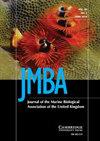Biological observations and new maximum reported sizes for two threatened rays: ornate eagle ray Aetomylaeus vespertilio and mangrove whipray Urogymnus granulatus from the Gulf of Mannar, India
IF 0.9
4区 生物学
Q3 MARINE & FRESHWATER BIOLOGY
Journal of the Marine Biological Association of the United Kingdom
Pub Date : 2023-11-21
DOI:10.1017/s0025315423000796
引用次数: 0
Abstract
Record-sized specimens of the ornate eagle ray印度马纳尔湾的两种濒危鳐的生物学观察和新报道的最大尺寸:华丽的鹰鳐aeetomylaeus vespertilio和红树林刺鳐Urogymnus granulatus
2021年和2022年,在印度泰米尔纳德邦马纳尔湾的Pamban岛,用一天的拖网渔船捕获了创纪录大小的雕鳐aeetomylaeus vespertilio和红树林刺鳐Urogymnus granulatus。所有鱼都在Pamban Therkuvadi鱼类登陆中心(FLC)登陆。最大的雕鳐的碟宽为384厘米,重530公斤,创下了该物种的新纪录,此前报道的最大尺寸为300厘米。该标本于2021年7月19日着陆。该物种的另一个大型标本(重360厘米,重453公斤)于2022年8月12日被捕获并上岸。登陆的红树鞭鱼重153厘米,总重150公斤,大于先前报道的最大尺寸141厘米重。研究了形态计量学、胃内容物和生殖状态。其中一只鹰鳐是一只怀孕的雌性,子宫里有三个足月的胚胎,而whipray是一只已经成年的雌性。鹰鳐胃内的主要猎物种类为大眼棘鱼(Selar crumenophthalmus)。红树林鞭鱼以一系列鱼类(猪脸鲷、山羊鱼、银腹鱼、银臀鱼和小沙丁鱼)和章鱼为食。
本文章由计算机程序翻译,如有差异,请以英文原文为准。
求助全文
约1分钟内获得全文
求助全文
来源期刊
CiteScore
2.30
自引率
8.30%
发文量
68
审稿时长
3-8 weeks
期刊介绍:
JMBA is an international journal, publishing original research on all aspects of marine biology. It includes pioneering work taking place today on major issues concerning marine organisms and their environment. Subjects covered include: ecological surveys and population studies of marine communities; physiology and experimental biology; taxonomy, morphology and life history of marine animals and plants; and chemical and physical oceanographic work. Included with 2010 online subscriptions: Marine Biodiversity Records.

 求助内容:
求助内容: 应助结果提醒方式:
应助结果提醒方式:


